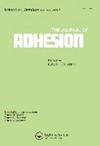固化温度对环氧铝单搭接接头力学性能的影响
IF 2.3
4区 材料科学
Q2 ENGINEERING, CHEMICAL
引用次数: 2
摘要
在相同的重叠部分采用不同刚度和强度的混合粘结接头是提高材料力学性能的良好策略。为此,使用不同的胶粘剂和不同的固化温度,其优化是实现机械性能最大化的关键。在此背景下,本研究采用Araldite®AV 4076 - 1/HY 4076和Araldite®AW 106/HV 953 U胶粘剂,评估固化温度对单搭接接头抗拉强度、蠕变和应力松弛响应以及疲劳强度的影响。可以得出结论,随着固化温度的升高,两种胶粘剂都表现出更高的静态强度、更低的应力松弛和更低的蠕变位移,但对于脆性胶粘剂来说,这种趋势在150°C时发生,而延性胶粘剂仅在70°C时发生。在此值之后,由于韧性胶粘剂随温度的降解,所有性能都恢复了。例如,考虑对应于抗拉强度25%的值,我们注意到延性胶粘剂比脆性胶粘剂松弛54.7%,蠕变位移约高95.1%。另一方面,脆性胶粘剂的疲劳寿命对固化温度不敏感,而延性胶粘剂的疲劳寿命在70℃后降低。因此,当这些粘合剂组合成混合粘合接头时,固化温度绝不能超过70℃。本文章由计算机程序翻译,如有差异,请以英文原文为准。
Effect of cure temperature on the mechanical properties of epoxy-aluminium single lap joints
ABSTRACT Mixed adhesive joints combining different stiffnesses and strengths in the same overlap is a good strategy to increase the mechanical properties. For this purpose, different adhesives with distinct curing temperatures are used, whose optimization is crucial to maximize the mechanical performance. In this context, this study considers Araldite® AV 4076–1/HY 4076 and Araldite® AW 106/HV 953 U adhesives to evaluate the effect of curing temperature on tensile strength, creep and stress relaxation response and fatigue strength of single lap joints. It was possible to conclude that both adhesives exhibited higher static strength, lower stress relaxation and lower creep displacements with increasing curing temperature, but while for the brittle adhesive this trend occurred up to 150°C for the ductile one it was only up to 70°C. After this value, all properties regressed due to the degradation of the ductile adhesive with temperature. Considering values corresponding to 25% of the tensile strength, for example, it was noted that the ductile adhesive relaxes 54.7% more than the fragile one and presents a creep displacement around 95.1% higher. On the other hand, while the fatigue life was shown to be insensitive to the curing temperature for the brittle adhesive, in the case of the ductile one it decreases after 70°C. Therefore, when these adhesives are combined into a mixed adhesive joint, the curing temperature must never exceed 70°C.
求助全文
通过发布文献求助,成功后即可免费获取论文全文。
去求助
来源期刊

Journal of Adhesion
工程技术-材料科学:综合
CiteScore
5.30
自引率
9.10%
发文量
55
审稿时长
1 months
期刊介绍:
The Journal of Adhesion is dedicated to perpetuating understanding of the phenomenon of adhesion and its practical applications. The art of adhesion is maturing into a science that requires a broad, coordinated interdisciplinary effort to help illuminate its complex nature and numerous manifestations.
 求助内容:
求助内容: 应助结果提醒方式:
应助结果提醒方式:


